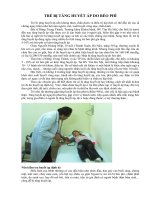Tài liệu Gynecologic Surgical Site Infections: Simple Strategies for Prevention docx
Bạn đang xem bản rút gọn của tài liệu. Xem và tải ngay bản đầy đủ của tài liệu tại đây (287.76 KB, 5 trang )
14 The Female Patient |
VOL 36 MARCH 2011 All articles are available online at www.femalepatient.com.
feature
With recent emphasis on all aspects
of patient safety, it is good to be
reminded of the basic protocols of
surgical site infection prevention.
G
ynecologic surgical site infections (SSIs)
most commonly arise when bacteria
that naturally occur on the skin or va-
gina contaminate an incision site. Other
potential sources of bacteria are skin-to-skin con-
tact with health care workers, as well as contami-
nated medical equipment. Despite widespread use
of prophylactic antibiotics, SSIs remain a major
issue facing the health care system today. Patients
who experience SSIs utilize more health care re-
sources, such as intravenous antibiotics and clini-
cian care, and are at greater risk for readmission
Gynecologic
Surgical
Site Infections:
Simple Strategies
for Prevention
Christa Lewis, DO
Patrick Culligan, MD, FACOG, FACS
LEWIS and CULLIGAN
Follow The Female Patient on
and
The Female Patient |
VOL 36 MARCH 2011
15
fOCuSPOINT
Antibiotic
prophylaxis
is utilized so
that the drugs
can augment
natural immune
function at the
skin level.
and death.
1
Should you suspect that a pa-
tient has an SSI, early identication and
treatment are critical.
Beyond patient care, SSIs are a key con-
sideration for an institution’s bottom line,
given the new mandatory reporting re-
quirement for hospitals. ey aect up to
500,000 patients per year and result in an
annual cost to hospitals of $7.4 billion.
2,3
As
of October 2008, the Centers for Medicare
and Medicaid Services (CMS) stopped re-
imbursing for treatment of certain health
care–associated conditions, including
SSIs that have evidence-based prevention
guidelines. Also, beginning in 2012, CMS is
requiring hospitals to use the CDC’s Na-
tional Healthcare Safety Network to report
incidences of SSIs in order to receive a full
Medicare reimbursement for payments in
2014. ese reported infections will be-
come public information, providing a
forum in which our institutions can be
evaluated by prospective patients and
professionals.
Many ObGyn professionals perceive ce-
sarean delivery as the surgery most likely to
result in an SSI, yet SSI incidence following
gynecologic surgeries is approximately 2%.
4
Still, SSI rates are not high enough to place
the issue at the top of the gynecologic sur-
geon’s mind. In fact, SSI prevention tech-
niques tend to become rote—and can then
be taken for granted. is article focuses on
a “best practices” approach to reducing the
risk of SSIs associated with gynecologic
surgery.
ANTIBIOTIC PROPHYLAXIS
Antibiotic prophylaxis is utilized so that the
drugs can augment natural immune func-
tion at the skin level—killing bacteria that
are inoculated into the surgical eld. ere-
fore, a narrow window of timing exists in
which to complete the antibiotic infusion.
For best results, prophylactic antibiotics
should be fully infused no longer than 2
hours before and no sooner than 30 minutes
before the incision time.
5
Due to their broad-spectrum activity and
low incidence to produce allergic reactions,
cephalosporins are the standard rst-line
choice for prophylaxis. Most commonly, ce-
fazolin (1 g) is used because of its 1.8-hour
half-life and low cost. For patients who are
morbidly obese (BMI >35), the antibiotic
dose should be increased to 2 g.
6
Repeat dos-
ing of prophylactic antibiotics should be
given at 1 or 2 times the estimated drug half-
life. In the case of cefazolin, the second dose
should be given at 3 hours.
7
Repeat dosing
should also be given in situations involving
blood loss greater than 1,500 mL.
7
In May 2009, ACOG issued a practice bul-
letin for antibiotic prophylaxis for gyneco-
logic procedures, which replaced the previ-
ous guidelines developed in 2006.
6
e
highlights from this publication are pre-
sented in Tables 1 and 2.
SKIN PREPARATION
Gynecologic infections are commonly
caused when the ora of the patient’s vagina
gains exposure to the surgical incision site
in the peritoneal cavity. is can happen
even when performing total laparoscopic
and supracervical hysterectomy proce-
dures. For this reason, it is important to pre-
pare the patient with a vaginal scrub as well
as skin antisepsis at the point of incision, in
order to reduce the amount of naturally oc-
curring bacteria on the skin.
Abdominal Incisions
When possible, the skin should be prepared
with a 2% chlorhexidine gluconate (CHG)/
70% isopropyl alcohol solution (such as
ChloraPrep
®
, CareFusion, Leawood, KS) for
abdominal access points. is formulation,
which is recommended for skin prepara-
tion, works by rapidly killing microorgan-
isms and providing persistent antimicrobial
activity for up to 48 hours.
Despite evidence that 2% CHG/70% iso-
propyl alcohol
is superior, many surgeons
are still using povidone-iodine for abdomi-
nal skin preparation. A drawback of using
povidone-iodine for skin preparation is that
iodine can be neutralized by blood and
other organic matter, reducing the eective-
ness and persistence. In addition, povidone-
iodine is not completely eective until thor-
Christa Lewis, DO, is a fellow in Urogynecology and
Reconstructive Pelvic Surgery, Atlantic Health, Mor-
ristown and Summit, NJ. Patrick Culligan, MD,
FACOG, FACS, is Director of Urogynecology and
Reconstructive Pelvic Surgery, Atlantic Health, Mor-
ristown and Summit, NJ; and Professor of Obstetrics,
Gynecology and Reproductive Science, Mount Sinai
School of Medicine, New York, NY.
20 The Female Patient |
VOL 36 MARCH 2011 All articles are available online at www.femalepatient.com.
Gynecologic Surgical Site Infection Prevention
oughly dried on the skin. Furthermore, a
recent study published in the New England
Journal of Medicine demonstrated that pre-
operative use of 2% CHG/70% isopropyl al-
cohol reduced total SSIs by 41% compared to
use of povidone-iodine solution.
8
Vaginal Incisions
Povidone-iodine surgical preparation is the
most commonly employed method in surgi-
cal procedures that require a vaginal scrub.
Alternatively, there has been some indica-
tion that a 4% aqueous CHG solution may
TABLE 1. ACOG Antimicrobial Prophylactic Regimens by Procedure
6a
Procedure Antibiotic Dose (Single Dose)
Hysterectomy Cefazolin
b
1 or 2 g
c
IV
Urogynecology procedures, Clindamycin
d
plus 600 mg IV
including those involving mesh gentamicin or 1.5 mg/kg IV
quinolone
e
or 400 mg IV
aztreonam 1 g IV
Metronidazole
d
plus 500 mg IV
gentamicin or 1.5 mg/kg IV
quinolone
e
400 mg IV
Laparoscopy None
Diagnostic
Operative
Tubal sterilization
Laparotomy None
Hysteroscopy None
Diagnostic
Operative
Endometrial ablation
Essure
Hysterosalpingogram Doxycycline
f
100 mg orally, twice daily for 5 days
or chromotubation
IUD insertion None
Endometrial biopsy None
Induced abortion/dilation Doxycycline 100 mg orally 1 hour before procedure
and evacuation and 200 mg orally after procedure
Metronidazole 500 mg orally twice daily for 5 days
Urodynamics None
Abbreviations: IV, intravenously; IUD, intrauterine device.
a
A convenient time to administer antibiotic prophylaxis is just before induction of anesthesia.
b
Acceptable alternatives include cefotetan, cefoxitin, cefuroxime, or ampicillin-sulbactam.
c
A 2-g dose is recommended in women with a BMI >35 or weight >100 kg or >220 lb.
d
Antimicrobial agents of choice in women with a history of immediate hypersensitivity to penicillin.
e
Ciprofloxacin or levofloxacin or moxifloxacin.
f
If patient has a history of pelvic inflammatory disease or procedure demonstrates dilated fallopian tubes.
Nonprophylaxis is indicated for a patient without dilated tubes.
LEWIS and CULLIGAN
Follow The Female Patient on
and
The Female Patient |
VOL 36 MARCH 2011
21
also be appropriate. One randomized trial
demonstrated that 4% aqueous CHG is more
eective than povidone-iodine in decreas-
ing the bacterial colony counts that were
found in the operative eld for vaginal hys-
terectomy.
9
Physicians and other operating
room personnel are often reluctant to use
CHG inside the vagina, due to the fact that
CHG is not appropriate for mucosal sur-
faces. However, despite common use of the
term “vaginal mucosa,” the vagina is lined
by an epithelial surface. As such, prepping
this surface with CHG is appropriate.
Hand Hygiene
Since microorganisms can be transferred
from the hands of a health care worker to a
patient, proper hand hygiene is a critical
measure to prevent pathogen transmission.
Glove use alone does not suce and does
not replace washing with soap and water
or hand-rubbing with an alcohol-based
solution.
Obviously, sterile technique dictates that
hand hygiene should be performed before
touching a patient or a device that will be
used for patient care. It should also be per-
formed after contact with bodily uids or
inanimate surfaces and objects and after
removing gloves.
As long as they are used properly, alcohol-
based solutions can provide hand prep-
aration on par with traditional surgical
scrubbing. According to the World Health
Organization Guidelines on Hand Hygiene
in Health Care,
10
the following technique
should be followed:
• Apply a palmful of alcohol-based han-
drub and cover all surfaces of the hands.
Rub hands until dry.
• When washing hands with soap and
water, wet hands with water and apply
the amount of product necessary to cover
all surfaces. Rinse hands with water and
dry thoroughly with a single-use towel.
Use clean, running water whenever pos-
sible. Avoid using hot water, as repeated
exposure to hot water may increase the
risk of dermatitis. Use towel to turn o
tap/faucet. Dry hands thoroughly using a
method that does not recontaminate
hands. Make sure towels are not used
multiple times or by multiple people.
• Liquid, bar, leaf, or powdered forms of
soap are acceptable. When bar soap is
used, small bars of soap in racks that fa-
cilitate drainage should be used to allow
the bars to dry.
Studies demonstrate that scrubbing for 5
minutes will reduce bacterial count just as
eectively as the previous practice of scrub-
bing for 10 minutes.
11
Furthermore, alcohol-
based waterless hand hygiene products are
being formulated to be gentler on the skin
and provide for easier glove application by
not leaving a residue on the skin. When re-
viewing data comparing waterless alcohol
scrub to conventional presurgical brush
hand scrub, the risk of SSIs is comparable
when either method is used correctly.
12
All ObGyns are familiar with the tradi-
tional hand scrub technique; however, the
technique employed for waterless hand
scrub has many misconceptions.
Proper technique for application of water-
less hand scrub is outlined below:
• One pump placed onto the palm of hand.
Opposite hand used to dip ngertips into
hand prep and work under ngernails.
en spread remaining prep over hand
and just above elbow. Second pump used
to repeat with other hand.
• ird pump placed into either hand and
reapplied to all aspects of both hands, up
to the wrists. Allow to dry without the use
of towels.
• Can be used as rst scrub of the day.
• If ngernails or hands are visibly soiled,
rst wash with soap and water prior to
application.
TABLE 2. ACOG Recommendations
and Conclusions for Gynecologic
Antibiotic Prophylaxis
6
• Patients undergoing hysterectomy should
receive single-dose antimicrobial prophylaxis
preoperatively.
• Pelvic inammatory disease occurs uncom-
monly with or without the use of antibiotic pro-
phylaxis, and so prophylaxis is not indicated at
the time of IUD insertion.
• Antibiotic prophylaxis is indicated for elective
suction curettage abortion.
• Antibiotic prophylaxis is not recommended in
patients undergoing diagnostic laparoscopy.
fOCuSPOINT
Proper hand
hygiene is a
critical measure
to prevent
pathogen
transmission.
22 The Female Patient |
VOL 36 MARCH 2011 All articles are available online at www.femalepatient.com.
Gynecologic Surgical Site Infection Prevention
Hair Removal
For gynecologic procedures, hair removal is
typically not needed, as incisions are rarely
made in the hairline. However, when preop-
erative hair removal is necessary, guidelines
recommend using a surgical clipper rather
than a razor. ese recommendations are
based on data that have shown a traditional
razor can cause microabrasions to the skin,
which can increase the risk of infection.
With a surgical clipper, the risk of trauma
to the skin is signicantly reduced. Dispos-
able, single-use blades help prevent cross-
contamination. Some clippers are designed
specically for the rather sensitive areas en-
countered during gynecologic surgeries.
One such product (Figure) is specically
shaped for ease of use on the groin and
perineum and is designed to be fully sub-
mersible in disinfectants, which can make
the cleaning easier and faster.
CONCLUSION
In recent years, we have made great progress
in reducing SSI incidence rates for gyneco-
logic procedures. However, we must not be-
come complacent because of these suc-
cesses. We must do everything in our power
to reduce the risk of infections for each pa-
tient we see.
SSIs are serious, but they are also prevent-
able. Proper infection prevention protocols
go beyond ensuring a clean operating room
and sterile equipment. ey start with re-
membering the basics, refusing to take
shortcuts, and always having the best inter-
est of the patient at the forefront.
e authors report no actual or potential con-
icts of interest in relation to this article.
REFERENCES
1. Centers for Disease Control and Prevention. Preven-
tion of MRSA Infections in Healthcare Settings. Avail-
able at: www.cdc.gov/mrsa/prevent/healthcare
.html. Accessed October 18, 2010.
2. Martone WJ, Nichols RL. Recognition, prevention,
surveillance, and management of surgical site
infections: introduction to the problem and sympo-
sium overview. Clin Infect Dis. 2001;33(Suppl
2):S67-S68.
3. Centers for Disease Control and Prevention (CDC).
Healthcare Infection Control Practices Advisory
Committee (HICPAC): HHS Efforts to Reduce Health-
care-associated Infections. Available at: www.cdc
.gov/ncidod/dhqp/pdf/hicpac/HHSpresentation
HICPAC_11_08.pdf. Accessed October 12, 2010.
4. de Lissovoy G, Fraeman K, Hutchins V, Murphy D,
Song D, Vaughn BB. Surgical site infection: incidence
and impact on hospital utilization and treatment
costs. Am J Infect Control. 2009;37(5):387-397.
5. de Vries EN, Dijkstra L, Smorenburg SM, Meijer RP,
Boermeester MA. The SURgical PAtient Safety Sys-
tem (SURPASS) checklist optimizes timing of antibi-
otic prophylaxis. Patient Saf Surg. 2010;4(1):6.
6. ACOG Committee on Practice Bulletins—Gynecol-
ogy. ACOG practice bulletin No. 104: antibiotic pro-
phylaxis for gynecologic procedures. Obstet Gynecol.
2009;113(5):1180-1189.
7. Dalton V. Perioperative venous thromboembolism
and antibiotic prophylaxis in obstetrics and gynecol-
ogy. Clin Obstet Gynecol. 2010;53(3):521-531.
8. Darouiche RO, Wall MJ Jr, et al. Chlorhexidine-alco-
hol versus povidone-iodine for surgical-site antisep-
sis. N Engl J Med. 2010;362(1):18-26.
9. Culligan PJ, Kubik K, Murphy M, Blackwell L, Snyder
J. A randomized trial that compared povidone iodine
and chlorhexidine as antiseptics for vaginal hysterec-
tomy. Am J Obstet Gynecol. 2005;192(2):422-425.
10. World Health Organization. WHO Guidelines on
Hand Hygiene in Health Care. 2009. Geneva, Switzer-
land: WHO Press. Available at:
.int/publications/2009/9789241597906_eng.pdf.
Accessed October 12, 2010.
11. Boyce JM, Pittet D. Guideline for hand hygiene in
health-care settings: recommendations of the
Healthcare Infection Control Practices Advisory
Committee and the HICPAC/SHEA/APIC/IDSA
Hand Hygiene Task Force. Society for Healthcare
Epidemiology of America/Association for Profession-
als in Infection Control/Infectious Diseases Society
of America. MMWR Recomm Rep. 2002;51(RR-16):
1-45.
12. Weight CJ, Lee MC, Palmer JS. Avagard hand antisep-
sis vs. traditional scrub in 3600 pediatric urologic
procedures. Urology. 2010;76(1):15-17.
FIGURE. SensiClip. Used with permission of
CareFusion, San Diego, CA.
fOCuSPOINT
SSIs are serious,
but they are also
preventable.









